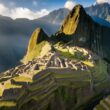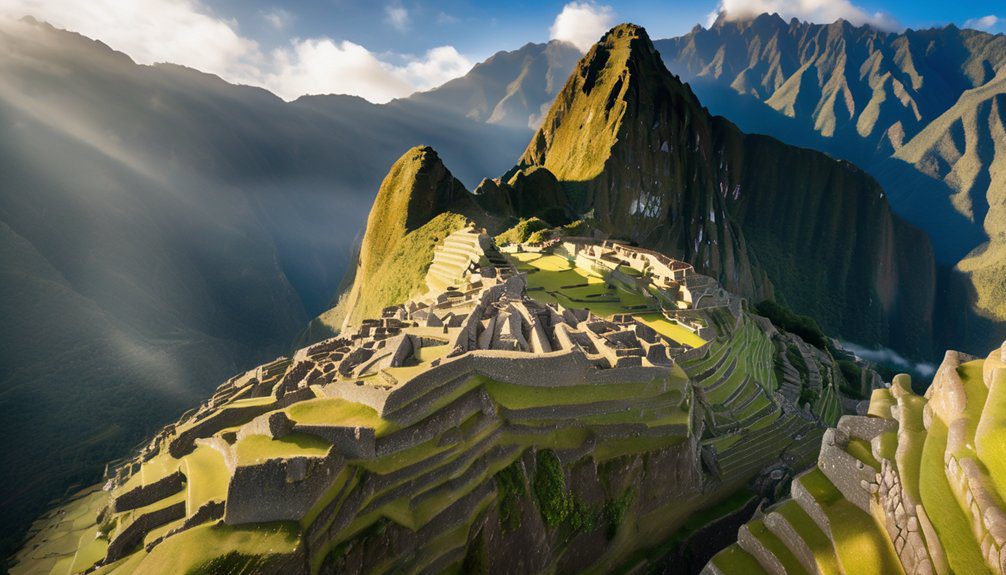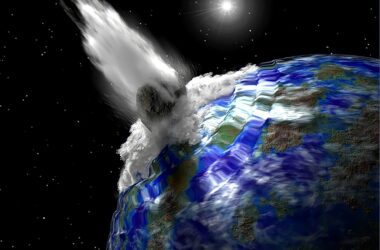Machu Picchu was built as a royal estate for Inca emperor Pachacuti, serving both political and religious purposes. Its remote location provided strategic defense and control, while its architecture showcased Inca engineering skills, like earthquake-resistant stonework and advanced water management. The site aligned with sacred mountains and celestial events, highlighting its spiritual role in honoring deities such as the sun god Inti. Understanding these aspects reveals why Machu Picchu was essential to Inca culture and governance.
The Historical Context of Machu Picchu
Although Machu Picchu is often celebrated for its breathtaking views, understanding its historical context is essential to grasp its true significance.
You should know it was built in the 15th century during the height of the Inca Empire. This site served as a royal estate for the emperor Pachacuti, showcasing Inca architectural skill and political power.
Its remote location provided strategic defense and control over surrounding regions. By studying its history, you gain insight into Inca society, engineering, and governance, all of which highlight why Machu Picchu was more than just a scenic landmark—it was a symbol of authority and innovation.
Religious and Ceremonial Significance
Since Machu Picchu was more than a royal retreat, it also held deep religious and ceremonial importance for the Inca people.
You’ll find that its location aligned with sacred mountains and celestial events, reflecting the Incas’ spiritual connection to nature.
Ceremonies conducted here honored deities like Inti, the sun god, reinforcing social unity and divine authority.
Ritual spaces, such as the Temple of the Sun, reveal how Machu Picchu functioned as a center for worship and offerings.
Understanding this significance helps you appreciate the site not only as an architectural marvel but also as an essential spiritual hub.
Architectural Innovations and Urban Planning
Beyond its spiritual roles, Machu Picchu showcases remarkable architectural innovations and thoughtful urban planning that highlight Inca engineering skills.
You can observe how the Incas designed the site to adapt to the mountainous terrain efficiently. Key features include:
- Terraced fields that prevent soil erosion and manage water flow.
- Stone structures built without mortar, allowing flexibility during earthquakes.
- An advanced drainage system that controls rainwater and prevents flooding.
- Strategic placement of buildings aligned with natural features and sun paths.
These elements reveal a sophisticated understanding of the environment, ensuring durability and harmony with nature.
Machu Picchu’s Role in Inca Society and Culture
When you examine Machu Picchu’s role in Inca society and culture, you’ll find it served multiple important functions beyond being a royal estate.
It acted as a religious center where ceremonies honored the sun god Inti, reflecting the Incas’ deep spiritual connection to nature.
The site also functioned as an agricultural laboratory, demonstrating advanced farming techniques.
Additionally, Machu Picchu symbolized political power and social organization, reinforcing the emperor’s authority.
Frequently Asked Questions
How Was Machu Picchu Rediscovered in Modern Times?
You’d discover Machu Picchu in 1911 when Hiram Bingham, exploring Peru’s mountains, stumbled upon its ruins. His finding freed ancient secrets from obscurity, inviting you to experience a lost civilization’s incredible legacy.
What Materials Were Used to Build Machu Picchu?
You’ll find Machu Picchu built mainly from granite stones, carefully cut and fitted without mortar. This precise stonework lets the structure endure earthquakes, showing how freedom in design creates lasting strength and harmony with nature’s forces.
Can Tourists Visit Machu Picchu Year-Round?
Yes, you can visit Machu Picchu year-round, but be ready for rainy season from November to March. Plan ahead, pack light, and embrace the freedom of exploring this iconic site whenever you choose to go.
What Wildlife Is Found Around Machu Picchu?
You’ll spot vibrant birds like the Andean cock-of-the-rock, playful spectacled bears, and curious llamas roaming freely. The lush cloud forest teems with butterflies and orchids, inviting you to explore nature’s wild, untamed beauty around Machu Picchu.
How Do Local Communities Benefit From Machu Picchu Tourism?
You’ll see local communities thrive as tourism creates jobs, boosts income, and supports small businesses. You’re helping preserve culture and environment while enjoying freedom to explore this historic site, connecting with traditions and nature firsthand.






